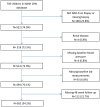Longitudinal assessment of high blood pressure in children with nonalcoholic fatty liver disease
- PMID: 25419656
- PMCID: PMC4242611
- DOI: 10.1371/journal.pone.0112569
Longitudinal assessment of high blood pressure in children with nonalcoholic fatty liver disease
Abstract
Objective: Nonalcoholic fatty liver disease (NAFLD) affects 9.6% of children and may put these children at elevated risk of high blood pressure and subsequent cardiovascular morbidity and mortality. Therefore, we sought to determine the prevalence of and risk factors for high blood pressure in children with NAFLD.
Methods: Cohort study performed by the NIDDK NASH Clinical Research Network. There were 484 children with NAFLD ages 2 to 17 at enrollment; 382 children were assessed both at enrollment and 48 weeks afterwards. The main outcomes were high blood pressure at baseline and persistent high blood pressure at both baseline and 48 weeks.
Results: Prevalence of high blood pressure at baseline was 35.8% and prevalence of persistent high blood pressure was 21.4%. Children with high blood pressure were significantly more likely to have worse steatosis than children without high blood pressure (mild 19.8% vs. 34.2%, moderate 35.0% vs. 30.7%, severe 45.2% vs. 35.1%; P = 0.003). Higher body mass index, low-density lipoprotein, and uric acid were independent risk factors for high blood pressure (Odds Ratios: 1.10 per kg/m2, 1.09 per 10 mg/dL, 1.25 per mg/dL, respectively). Compared to boys, girls with NAFLD were significantly more likely to have persistent high blood pressure (28.4% vs.18.9%; P = 0.05).
Conclusions: In conclusion, NAFLD is a common clinical problem that places children at substantial risk for high blood pressure, which may often go undiagnosed. Thus blood pressure evaluation, control, and monitoring should be an integral component of the clinical management of children with NAFLD.
Conflict of interest statement
Figures
References
-
- Schwimmer JB, Deutsch R, Kahen T, Lavine JE, Stanley C, et al. (2006) Prevalence of fatty liver in children and adolescents. Pediatrics 118:1388–1393. - PubMed
-
- Din-Dzietham R, Liu Y, Bielo MV, Shamsa F (2007) High blood pressure trends in children and adolescents in national surveys, 1963 to 2002. Circulation 116:1488–1496. - PubMed
-
- Bao W, Threefoot SA, Srinivasan SR, Berenson GS (1995) Essential hypertension predicted by tracking of elevated blood pressure from childhood to adulthood: the Bogalusa Heart Study. Am J Hypertens 8:657–665. - PubMed
Publication types
MeSH terms
Substances
Grants and funding
- U01DK061713/DK/NIDDK NIH HHS/United States
- U01 DK061731/DK/NIDDK NIH HHS/United States
- U01 DK061718/DK/NIDDK NIH HHS/United States
- P30 DK078392/DK/NIDDK NIH HHS/United States
- UL1 TR000006/TR/NCATS NIH HHS/United States
- UL1 TR000058/TR/NCATS NIH HHS/United States
- U01DK061728/DK/NIDDK NIH HHS/United States
- UL1 TR000439/TR/NCATS NIH HHS/United States
- UL1 TR000454/TR/NCATS NIH HHS/United States
- UL1TR000100/TR/NCATS NIH HHS/United States
- U01 DK061737/DK/NIDDK NIH HHS/United States
- U01 DK061713/DK/NIDDK NIH HHS/United States
- UL1TR000423/TR/NCATS NIH HHS/United States
- UL1TR000454/TR/NCATS NIH HHS/United States
- UL1TR000150/TR/NCATS NIH HHS/United States
- U01 DK061732/DK/NIDDK NIH HHS/United States
- UL1 TR000150/TR/NCATS NIH HHS/United States
- UL RR031980/RR/NCRR NIH HHS/United States
- U01DK061731/DK/NIDDK NIH HHS/United States
- U01DK061737/DK/NIDDK NIH HHS/United States
- P30 DK026743/DK/NIDDK NIH HHS/United States
- UL1TR000058/TR/NCATS NIH HHS/United States
- U01DK061718/DK/NIDDK NIH HHS/United States
- U01DK061732/DK/NIDDK NIH HHS/United States
- UL1 TR000436/TR/NCATS NIH HHS/United States
- U01 DK061730/DK/NIDDK NIH HHS/United States
- UL1TR000077/TR/NCATS NIH HHS/United States
- U01 DK061728/DK/NIDDK NIH HHS/United States
- UL1TR000448/TR/NCATS NIH HHS/United States
- UL1TR000436/TR/NCATS NIH HHS/United States
- U01 DK061738/DK/NIDDK NIH HHS/United States
- UL1 TR000424/TR/NCATS NIH HHS/United States
- UL1TR000040/TR/NCATS NIH HHS/United States
- UL1 TR000067/TR/NCATS NIH HHS/United States
- UL1TR000004/TR/NCATS NIH HHS/United States
- UL1 TR000448/TR/NCATS NIH HHS/United States
- U01 DK061734/DK/NIDDK NIH HHS/United States
- UL1 RR031980/RR/NCRR NIH HHS/United States
- UL1TR000439/TR/NCATS NIH HHS/United States
- UL1 TR002319/TR/NCATS NIH HHS/United States
- UL1 TR000040/TR/NCATS NIH HHS/United States
- UL1 TR000077/TR/NCATS NIH HHS/United States
- UL1 TR000423/TR/NCATS NIH HHS/United States
- UL1 TR000100/TR/NCATS NIH HHS/United States
- UL1TR000067/TR/NCATS NIH HHS/United States
- U01DK061738/DK/NIDDK NIH HHS/United States
- UL1TR000424/TR/NCATS NIH HHS/United States
- UL1 TR000004/TR/NCATS NIH HHS/United States
- U01DK061734/DK/NIDDK NIH HHS/United States
- UL1TR000006/TR/NCATS NIH HHS/United States
- U01DK061730/DK/NIDDK NIH HHS/United States
LinkOut - more resources
Full Text Sources
Other Literature Sources
Medical


